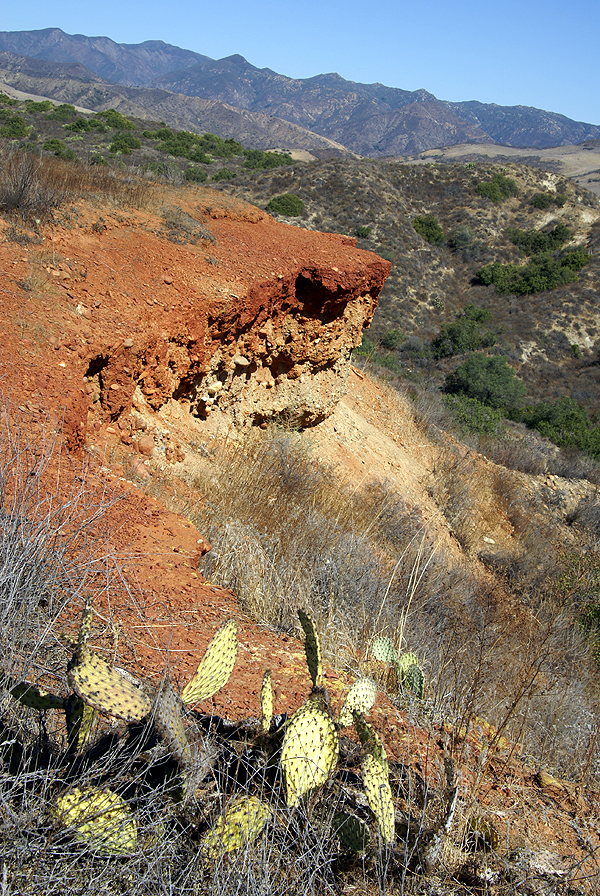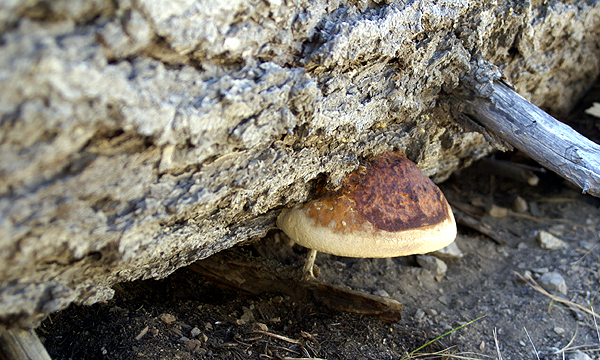Every now and then I'll get some decent pictures while I'm doing some urban caching, but most of the time, I very rarely take pictures. How many pictures can you get of Wal-Mart parking lots while checking under a lamp post skirt?
Usually, it's the pictures while out on a hike I find most interesting. Sometimes it's just little things, like a layer of rock that's a different color than the surrounding rock.  The capstone formation of rock on the hike that we took a couple of weeks ago down near San Juan Capistrano was extraordinarily red in color. It reminded me of Bryce Canyon National Park in many way. I remember remarking about the trail and the surrounding area reminding me about a similar trail up near Claremont where I live. There is a cache on that trail called Flashback. The cache owner called it that because it reminded him a lot of trails that he'd ridden in Utah. So it's like a three tiered remembrance of a basic spot if you like, but the point is the area reminded me strongly of Utah due to the red rock capstone on which we were walking. In the shot, I felt everything came together quite nicely. You wouldn't know there's several million people living just 10 miles to the left of the view in the picture.
The capstone formation of rock on the hike that we took a couple of weeks ago down near San Juan Capistrano was extraordinarily red in color. It reminded me of Bryce Canyon National Park in many way. I remember remarking about the trail and the surrounding area reminding me about a similar trail up near Claremont where I live. There is a cache on that trail called Flashback. The cache owner called it that because it reminded him a lot of trails that he'd ridden in Utah. So it's like a three tiered remembrance of a basic spot if you like, but the point is the area reminded me strongly of Utah due to the red rock capstone on which we were walking. In the shot, I felt everything came together quite nicely. You wouldn't know there's several million people living just 10 miles to the left of the view in the picture.
Other times, the pictures sneak up on you, or rather the spot sneaks up on you and you end up taking an interesting picture. The large bracken fungus that we found last week was just attached to this downed tree. The thing that stood out about it was its size. The picture doesn't really do it justice. I estimate that it was at least 8 to 10 inches in length. It was really fat, which I think contributed to it, but the size, coloring and overall appearance of the fungus made me think someone had wedged an extra large pancake into the side of this tree. You can almost see the syrup running over the top of the pancake and down the side.
A little bit earlier in the same hike we had to climb up on some rocks to find a cache. Along the side of the largest boulder, which was probably the size of a small house, was a little sapling clinging to life in a crack on the side of this boulder. I have to admit, it's a terrible picture of the tree because it just blends into the rock and such.  The lighting is poor, but I liked the way the tree was clinging to life, making it work. It was a surprise for us to see this little tree growing there. In ways it reminded me of the Jeffrey Pine that used to cling to life on top of Sentinel Dome in Yosemite National Park.
The lighting is poor, but I liked the way the tree was clinging to life, making it work. It was a surprise for us to see this little tree growing there. In ways it reminded me of the Jeffrey Pine that used to cling to life on top of Sentinel Dome in Yosemite National Park.
That pine tree clung tenaciously to life for several hundreds of years, growing to a height of only about 10 fee tall. Lightning and lack of any kind of soil on this exposed piece of rock contributed to its stunted condition. Sometime during the drought of the late 70s, it finally died. I had photographed it several times before it died and I have a black and white picture of it that I took in August of 1975. I processed it in our photography lab in high school and it still hangs on the wall in our bedroom. In 2000, the last time I was in Yosemite, I took the kids and we hiked to the top of the Dome. I had been in denial for many years, refusing to believe that my favorite tree had succumbed, yet knowing it had. When we reached the summit, I said hello to my old friend, now long dead. We took several pictures of it and with the kids around it. My older son's picture turned out so well that we made it his "school" picture for that year. Two years later the tree further succumbed to the elements and is now downed. Weather permitting, we'll try to make it to the top of Sentinel Dome again and see what's left.
I have another picture of another tree in a similar situation. I was with a group that was beginning a backpacking trip into the Sierra from the eastern side at Mammoth Lakes. We'd spent one night on the eastern side of Owens  Valley in the bristlecone pine area and were going to spend a night in Reds Meadow near Devil's Postpile National Monument. On top of the postpile, the columns are worn smooth from glaciation that moved through the area during the last ice age. Many of the columns are six sided shapes and the top of the postpile looks like a giant patio created from interlocking stones. I took a picture of a small sapling growing between a couple of these columns. It was about two feet tall at the time back in 1977. I keep thinking that one of these years I should get back there to see if it's still around. With the amount of traffic the postpile gets on an annual basis, it's likely that it didn't survive long, but if it did, I wonder what 30 years with little soil to help it along would cause it to look like?
Valley in the bristlecone pine area and were going to spend a night in Reds Meadow near Devil's Postpile National Monument. On top of the postpile, the columns are worn smooth from glaciation that moved through the area during the last ice age. Many of the columns are six sided shapes and the top of the postpile looks like a giant patio created from interlocking stones. I took a picture of a small sapling growing between a couple of these columns. It was about two feet tall at the time back in 1977. I keep thinking that one of these years I should get back there to see if it's still around. With the amount of traffic the postpile gets on an annual basis, it's likely that it didn't survive long, but if it did, I wonder what 30 years with little soil to help it along would cause it to look like?
Over the course of time that I've spent geocaching, I've come to appreciate the subtleties and little surprises that happen out on the local trails. I like to travel to national parks to do my camping and to appreciate the beauty this country has to offer. But I've come to realize, that I don't necessarily have to travel thousands of miles to find that beauty or see plants defying nature. Much of it can be found in my own back yard.
Pictures were taken at or near the following geocaches:
East Ridge - Red Rock - by chaosmanor
Hawk Hill - by Badgerdawg
4 Corners Among the Boulders - by RAD4SAND
Friday, October 24, 2008
Natural surprises
Posted by
Paul Myers
at
10:05 PM
Labels: geocaching, hike, outdoors, Ribbit
Subscribe to:
Post Comments (Atom)

2 comments:
Due to illness and general Life, I've not recently had a lot of time to reply to the blogs here, but this one caught my fancy. I'm in complete agreement with you; I've found a tremendous amount of natural wonder and beauty within 20 miles of home. Which doesn't mean that I'm falling out of love with the Mojave or the redwoods! All it means is that I've gotten a lot better at really *seeing* the world around me, both up close and far away. If more of us took the time to get out of our self-made boxes (prisons, is more like it) and look around at the close-to-home, I think a lot of the world's problems would simply vanish, as people would be too busy working on local issues to have time for worrying about what people hundreds or thousands of miles away are doing.
While I like all three of your photos, I actually like the one of the tree in the rock the best. You may think it didn't come out well; I disagree. Texture tells much of the story, and your shot captured that exceptionally well. You can tell bark from stone, see where bark and stone meet, and then when the two meld almost into one "alloy": very nicely done, IMUO. The fact that the colors are almost the same adds much to the aura, rather than detracting from it. If I had a criticism, it would be that we don't see more of the top of the tree, but that is a tiny quibble.
I suppose that I ought to start a blog of my own, or make better use of the webpage from Verizon that we get, if only to post some of my own photos and musings thereupon. Geocaching (and letterboxing and geodashing, etc) still has the power to take us to places we wouldn't normally go, and might never hear about. We are silly if we don't take advantage of that.
I've found the format that Blogspot uses to be very user friendly. There is a limit to the amount of pictures you can directly post to Blogspot, but most of my pictures are posted at geocaching.com too, so they're just linked from that site.
Post a Comment